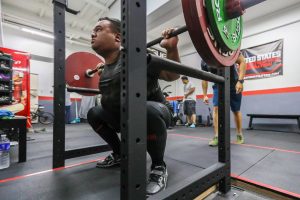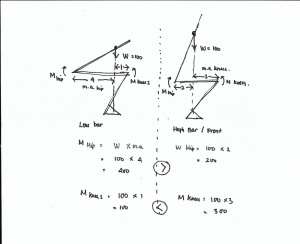A heavy bar is loaded on your back. You start descending, bending your knees and hips so that your hip crease dips below the top of your patella. You try to get back up, but darn, it’s heavy! Here comes your natural instinct to survive – raising the chest up, in the hope that the bar will follow. This is what I usually call a “chesty” squat. Even worse, you might start looking up! Because you’ve got to look up to go up, right? Well, well. If this is you, please read this article to understand how your survival reaction is detrimental to the lift.
Biomechanics of a squat
After reaching depth in a squat, you have 2 simple things to do to get back up. Straightening your knees and hips back to a standing position – knee and hip extension.
The muscles involved in these processes are the biggest, strongest muscle groups in the human body. Let’s break down the musculature involved in the movement.
The quadriceps is a four-headed muscle (thus the name) that extends your knees. In case you’re wondering where your quads are, it’s the big piece of muscle located on the front of your thigh. Now, try extending your knee joint as hard as can – this “flexes” your quads!
Your hip extensors consist of a tag team of 3 muscle groups: your glutes, hamstrings, and adductors. Glutes, the buttocks muscle, are the biggest muscle group in the human body. There’s a high chance that you are sitting on them right now reading this article. Hamstrings are located on the back part of your thigh and it has two functions – to straighten the hip and bend your knees. Lastly, the adductors are the ones on your inner thigh.
The hip extensors are more significant in size and strength as compared to the knee extensors. It’s a bigger engine!
Now imagine this scenario – you are hanging off a cliff and require help from someone to pull you up. You see, a few people are trying to help you (while some are just recording it to post on Facebook!). However, you have two choices, to be pulled by Hafthor Bjornsson (one of the world’s strongest man) or to get help from Marvin (pretty strong too but nowhere close to being the strongest man in the world). Assuming both are willing to help, who do you trust your life with? If you still want to live, I think Hafthor will be a better option. Why? Because he is much stronger, and thus more reliable to do the task.
Similarly, if you want to squat heavy weights, you want to call on the strongest muscles to do the job.
The physics of squat
In order for our hip and knees to extend, the muscle needs to contract and pull our bones. These contractions create rotational forces in the joints. We can calculate the minimum force that our body needs to generate to counter the weight by multiplying the load with the perpendicular distance of the load to the center of rotation.
Moment force = Weight x Moment Arm
Here, the concept of leverage applies. The longer the moment arm, the bigger the turning force/moment.
Our femur’s length is fixed, but we can manipulate the moment arm from both joints by controlling the knee position and back angle. Stand up and try this. Squat down to down while trying to keep your back as vertical as possible. Do your knees goes far forward? Now allow your back to be as horizontal as possible. Do your knees automatically being pulled back?
Knowing that your back angle will affect your knee position, here’s a mathematical example. Assume that the femur length is 5 units, and all other segments are equal in size.
We can see that squatting with a more vertical back put more load to the knees and less on the hips. Squatting with a more horizontal back allows us to use more of the hip extensor muscles.
Back to the main discussion: How does raising your chest affect the movement?
More often than not, when the bar is heavy, raising the chest up doesn’t create much upward movement to the bar. Instead, it changes the back angle more vertically while the bar stays mostly stationary. Borrowing the concept we just learned – what happens when the back is more vertical? The knees will go forward. And it will look like a high bar/ front squat, creating a longer moment arm between the bar and the knees. Thus more moment force to be loaded on the smaller knee extensor muscle group. It’s like saying to Hafthor, “Go away! Let Marvin help me!” Such a waste of Hafthor’s strength!
Takeaways and the fix
Always let “Hafthor” helps you! Use the bigger, stronger muscle group to lift the bar. In the gospel of Mark Rippetoe, this is called: HIP DRIVE (read: hip draaahve). If you train using the Starting Strength method, this will be one of the first things you learn.
Some cues you can use:
1. Sit back – even as you are going up. Keep your arse back to the wall. You might want to keep your hip back longer than you think you need to. Imagine that there’s a wall behind you, and you need to slide your arse up against the wall.
2. Chest down / point your nipples down – pardon the language, but to be mistaken with intentionally pushing your chest down as you are going up. We want you to keep pointing your chest to the floor and maintaining your back angle. It’s almost like looking at yourself in an imaginary mirror on the floor.
3. Eyegaze – sometimes a problem might arise from the habit of looking too far up/forward during the squat, or worse, shifting your eye gaze up during the ascent. Quick solution, fixing your eye gaze to a position 1m to 1.5m in front of you. Keep staring at the same point throughout your squat!
Limitation
This article is written under the assumption that you can maintain your balance in the middle of the foot.
If you’d like to discuss more on this topic, please feel free to leave a comment here.



